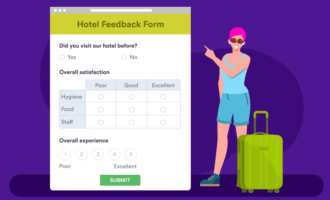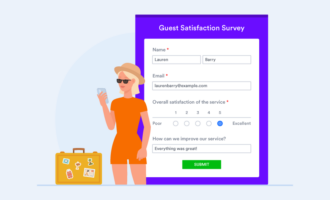The quality of your survey questions can make or break the data you collect. Whether you’re using a survey to gather reactions to a new product or service, information about a particular demographic, or feedback after an event, you should make the survey questions as clear as possible.
Just as you wouldn’t give your participants a survey written in a language they don’t understand, you should avoid questions that leave your participants scratching their heads and trying to figure out what you’re looking for.
In this article, we’ll break down what makes a survey question ambiguous, give some examples of what to avoid and how to fix ambiguity, and explain how a survey tool like Jotform can help prevent ambiguous survey questions.
Examples of ambiguous survey questions
An ambiguous question is unclear or imprecise, often leading to confusion or multiple interpretations. Ambiguity can be the result of using vague language, not providing enough context, or including nonspecific terms that readers could easily interpret in multiple ways.
The less confusion your participants feel when completing your survey, the more accurate your data will be.
Here are some examples of ambiguous survey questions and ways you could rephrase them to be clearer:
- Question 1: “How satisfied are you with the service?”
Problem: The question lacks specificity — which aspects of “the service” are respondents being asked about?
Solution: Ask about the different categories of service, such as speed, friendliness, and accuracy — for example, “How satisfied are you with the speed of the service provided?” Provide a range of optional answers for each category of service: “Extremely satisfied,” “Very satisfied,” “Satisfied,” “Somewhat satisfied,” “Not satisfied.”
- Question 2: “How frequently do you walk your dog?”
Problem: What does “frequency” mean specifically? What time interval is being used?
Solution: “How many times do you walk your dog in a week?” Provide specific answer options, for example: “Three times a day or more,” “One to two times a day,” “A few times a week,” “Once a week.”
- Question 3: “What is your income level?”
Problem: Without defining exactly what “income” refers to, respondents may provide different figures.
Solution: “What is your annual gross income?”
- Question 4: “Do you prefer shopping online or in a store?”
Problem: The question is overly general and doesn’t specify what type of products the respondent may be shopping for, making it difficult for them to answer.
Solution: “When shopping for [category of good], do you prefer looking online or in a store?”
- Question 5: “How often do you eat out?”
Problem: “Eat out” can include different things (e.g., fast food, casual dining, and fine dining), which will make survey responses less useful if you want to focus on a specific category of dining.
Solution: “How often do you dine at different types of restaurants?” For each category of restaurant you include, list the following answer options: “One to two times per month,” “Three to five times per month,” “Six to 10 times per month,” “More than 10 times per month.”
5 ways ambiguous survey questions may harm your survey
1. Misinterpretation
If a question is too ambiguous, chances are your respondents will interpret it in different ways. By providing clear guidance on what information you’re trying to gather, you can prevent your data from being skewed.
2. Inaccurate analysis
If it’s unclear what your questions are measuring, you may struggle to interpret the data gathered from the survey correctly. You can arrive at flawed conclusions and make decisions based on inaccurate information.
3. Less effective data
A survey question that’s unclear or confusing can make people give up on your survey altogether. They might feel like your survey isn’t worth the time it takes to decipher it. This could lead to fewer responses or less reliable answers. If you keep things straightforward, you’ll have the best chance of collecting accurate, valuable insights.
4. Difficult comparisons
If you’re comparing your survey results to other responses about a similar topic, keep things as clear as possible. Ambiguity can make it impossible to detect patterns and make smart, data-driven decisions — especially if you want to compare answers from different demographics.
5. Risk of biases
People may interpret questions differently based on their own ideas and biases. Stay aware of how ambiguous questions can make things murky, so you can take steps to ensure your surveys are crystal clear for everyone.
A powerful way to avoid ambiguous survey questions and collect high-quality data: Jotform
Creating surveys without ambiguous questions is crucial for gathering accurate and actionable data. With Jotform’s comprehensive suite of survey tools and templates, crafting clear and concise surveys has never been easier.
Whether you’re looking to gather open-ended responses, multiple-choice answers, or Likert scale ratings, Jotform offers a variety of customizable fields tailored to suit your needs. Using these diverse fields makes it easier to develop questions that eliminate ambiguity and maximize the usefulness of the data you collect.
Jotform also offers a long-text field option, which has a generous limit of 65,535 characters. Because this field allows respondents to provide detailed responses and ensure clarity and depth in their answers, it offers another way to avoid collecting vague answers from survey participants.
Plus, with Jotform Tables, tracking and analyzing survey responses is seamless and efficient, empowering you to gain insights and make informed, evidence-based decisions.
By leveraging Jotform’s intuitive platform and robust features, you can create surveys that yield valuable, clear insights, setting the stage for meaningful analysis and action.
Photo by cottonbro studio






































































































Send Comment: